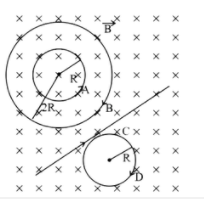Two particles A and B of mass mA and mB respectively and having the same charge are moving in a plane. A uniform magnetic field exists perpendicular to this plane. The speeds of the particles are vA and vB respectively, and the trajectories are as shown in the figure. Then
 Solution in Telugu
Solution in Telugu
mAvA<mBvB
mAvA>mBvB
mA<mB and vA<vB
mA=mB and vA=vB
The correct Answer is:B
Step by step video, text & image solution for Two particles A and B of mass m_(A) and m_(B) respectively and having the same charge are moving in a plane. A uniform magnetic field exists perpendicular to this plane. The speeds of the particles are v_(A) and v_(B) respectively, and the trajectories are as shown in the figure. Then by Physics experts to help you in doubts & scoring excellent marks in Class 12 exams.
Updated on:21/07/2023Topper's Solved these Questions
- MOVING CHARGES AND MAGNETISMBOOK - AAKASH SERIESCHAPTER - MOVING CHARGES AND MAGNETISMEXERCISE - EXERCISE-III
45 Videos
- MOVING CHARGES AND MAGNETISMBOOK - AAKASH SERIESCHAPTER - MOVING CHARGES AND MAGNETISMEXERCISE - EXERCISE-IB
71 Videos
- MOTION IN A STRAIGHT LINE BOOK - AAKASH SERIESCHAPTER - MOTION IN A STRAIGHT LINE EXERCISE - very Short answer type question
15 Videos
- NUCLEAR PHYSICSBOOK - AAKASH SERIESCHAPTER - NUCLEAR PHYSICSEXERCISE - ADDITIONAL PRACTICE PRACTICE SHEET (ADVANCED) Integer Type Questions
4 Videos
Similar Questions
A proton, a deuteron and an a particle having same momentum enter a uniform magnetic field at right angles to the field. Then the ratio of their angular momenta during their motion in the magnetic field is
View Solution(A) : Magnetic field interacts with a moving charge and not with a stationary charge.
(R) : Magnetic field will be produced by a moving charge but not by a stationary charge.
View SolutionGive two examples of the motion of big objects where the object can be treated as a particle and where it cannot be?
View SolutionIn a sample of rock, the ratio of number of 206Pb to 238U nuclei is found to be 0.5. The age of the rock is (18/n)×109ln(32)ln2 year (Assume that all the Pb nuclides in he rock was produced due to the decay of Uranium nuclides and T1/2(238U)=4.5×109 year). Find n.
View SolutionTwo particles A and B of masses m_(A) and m_(B) respectively and having the same charge are moving in a plane . The speeds of the particles are v_(A) and v_(B) respectively and the trajectories are as shown in the figure. Then
View SolutionTwo particles A and B of masses m_A and m_B respectively and having the same charge are moving ina plane. A uniform magnetic field exists perependicular to this plane. The speeds of the particles are v_A and v_B respectively and the trajectories are as shown in the figure. Then,
View SolutionTwo masses mA and mB moving with velocities vA and vB in opposite direction collide elastically after that the masses mA and mB move with velocity vB and vA respectively. The ratio (mA/mB) is
View SolutionTwo particles A & B of mass m1 and m2 respectively start moving from O with speeds v1, and v2. A moves towards the plane mirror and B moves parallel to mirror horizontally. The mirror is in y-z plane. The absolute-speed of image of centre of mass of the system (image of A + image of B)is:

View SolutionTwo particles of mass mA and mB and their velocities are VA and VB respectively collides. After collision they interchanges their velocities, then ratio of mAmB is
View Solutionदो कण A तथा B जिनके द्रव्यमान क्रमशः mA तथा mB तथा जिनके आवेश समान है, एक तल में गतिमान है। इस तल के लंबवत एक चुंबकीय क्षेत्र विधमान है। कणों की चालें क्रमशः vA तथा vB तथा प्रक्षेप-पथ चित्रानुसार है। तब:

View SolutionTwo particles A and B of masses mAandmB respectively and having the same charge are moving in a plane. A uniform magnetic field exists perpendicular to this plane. The speeds of the particles are vAandvB respectively and the trajectories are as shown in the figure. Then -

View SolutionFour particles A, B, and C and D of masses mA,mB,mBandmD respectively, follow the paths shown in the figure, in a uniform magnetic field. Each particle moving with same speed. QA,QB,QCandQD are the specific charge of particles A, B, C and D respectively (assume that the motion of each particle is in the same plane perpendicular to the magnetic field).

View Solutionएक कण जिसका द्रव्यमान m1 है v1 वेग से गति कर रहा है । एक दूसरा कण जिसका द्रव्यमान m2 है, v2 वेग से गति कर रहा है। इन दोनों का संवेग समान है, परन्तु इनकी गति ऊर्जाएं क्रमश E1 और E2 है । यदि m1>m2 हो, तो
View Solutionदो द्रव्यमान mAव mB विपरीत दिशा में vAतथाvB में वेग से गतिशील है तथा परस्पर प्रत्यास्थ संघट्ट करते है। संघट्ट के पश्चात mA तथा mBक्रमशः vBव vAवेग से गति करने लगते है (mA/mB)का अनुपात है
View SolutionTwo particles A and B of masses mA and mB respectively and having the same charge are moving ina plane. A uniform magnetic field exists perependicular to this plane. The speeds of the particles are vA and vB respectively and the trajectories are as shown in the figure. Then,

View Solution
